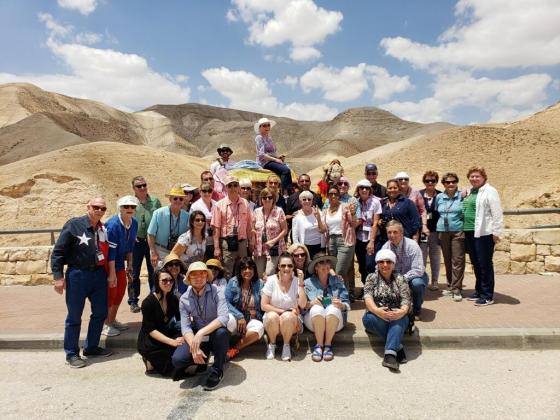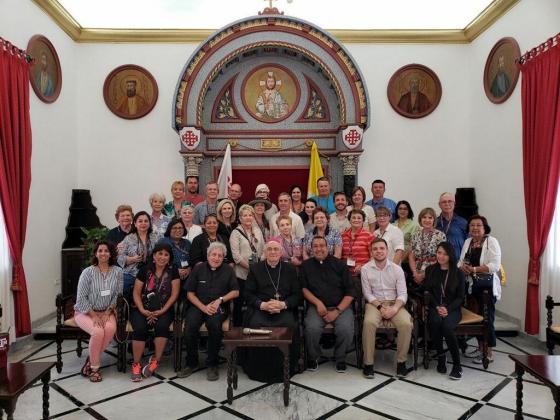Holy Land trip brings faith “home”
For 10 days in May 35 pilgrims that included parishioners from Navasota’s Christ Our Light Catholic Church and St. Stanislaus Catholic Church in Anderson walked in the footsteps of Jesus and His disciples. But in this age of “virtual” tours, why fly halfway around the world to the Holy Land?
Christ Our Lights’ Father Eli Lopez who arranged the tour said, “It’s important because this is a holy site for Christians and all denominations, and with the number of Christians dwindling, we don’t want to lose that part of our heritage and our history. To bring people to experience where Jesus talked and walked, is so important.”
He continued, “We celebrated Mass at various holy sites and the readings pertained to that site. When you’re back home on Sundays, when you hear the Gospel read, you think ‘I was there. I can picture it.’ Just being a part of that really opens up your heart and mind to truly experience Jesus in your life.”
The full itinerary included many sites significant to Christians such as Caesarea where the apostle Paul was held prisoner, a boat ride on the Sea of Galilee, and the site of the Sermon on the Mount in Capernaum. There was a stop in Cana where Jesus turned water into wine and tour couples renewed their wedding vows before traveling to Bethlehem. In Jerusalem, Mass in the Garden of Gethsemane preceded the cave of betrayal, retracing the last steps of Christ and the Wailing Wall, sacred to Jews worldwide.
Cradle of many faiths
Father Eli came to Christ Our Light in 2017 and is no stranger to the Holy Land. This was his fourth trip, the first two while a seminary student. In the summer of 2013, he studied for seven weeks at the Tantur Ecumenical Institute in Jerusalem to learn about the different religions.
He said, “The three major religions are all right there in the Holy Land, Judaism, Christianity and Islam but not only the three religions, there are a lot of different religions as well, like the Druze and Baha’i.”
His mornings were filled with lectures, but afternoons were spent visiting the sites they studied with lunch in a different family’s home to learn more about the culture, the people and their religion.
According to Father Eli, the tension has declined since his last trip in 2017 but “the conflict is still there.”
He continued, “It’s been under conflict for thousands of years. And now Christians are down to 3 percent of the population. While I was there studying, it gave me a sense of the need to bring people to the Holy Land to experience it.”
Exodus
The itinerary allowed time to visit Christian stores that sell goods made from olive wood.
Father Eli explained, “it’s hard for the younger generation to stay and make a living. We visited a shop and below the shop they had a factory where these men were making with their hands, beautiful art carvings from olive wood. It’s like the whole community that’s left in Bethlehem has pooled their resources together and that’s how they’ve sustained their living.”
The Christians he refers to are Palestinian. He said, “Most people think Arabs are Muslim but in Arab countries there are Christians. It’s the Christians who get caught in the middle of the conflict between Islam and the Jews.”
According to Father Eli, a wall built around Bethlehem makes it difficult for people to travel the 7 miles between Bethlehem and Jerusalem to and from work.
He said, “if you live in Bethlehem and work in Jerusalem, you have to go through this checkpoint every day to get to work. It can be one hour, two hours, three hours or half a day because of the level of security they have. It makes it difficult for the Christians who get caught between the conflict to maintain their livelihood. That is why a lot of the young people have left.”
A new perspective
Perhaps an unexpected outcome of the Holy Land pilgrimage is a better understanding of the universality of the Christian faith and a broadened perspective of the world.
Father Eli said, “When you are visiting all these sites, there are different tour groups from all-around the world – from India, Africa, Germany, Poland, Russia, and it puts it into perspective that these are all Christians, young and old. For me, it’s encouraging when you go on a pilgrimage like this and see lots of young people because you hear how young people are leaving the faith. But when you’re there and see so many young people praying at these Holy sites, it gives you hope for the future. You don’t realize how universal our faith is.”
He added that it’s easy to get caught up in our own part of the world but encountering people from different faiths from all parts of the world provides a different perspective.
Love one another
Jesus’ message to love one another as He has loved us is one of the most difficult and challenging things to do. The rise of Islam in the past 15 years in countries that were mission territories has made it very difficult for missionaries.
.
Father Eli said, “Christians today are being martyred around the world. So many are being driven from their homes and their countries. I’d like for people to pray for Christians, not just in the Holy Land, but Christians throughout the world who are being persecuted and martyred... It’s so important that we maintain these holy sites and for people to understand how difficult it is for Christians outside of our world, outside of where we live, and the struggle they’re facing.”


